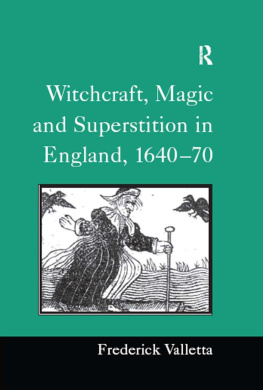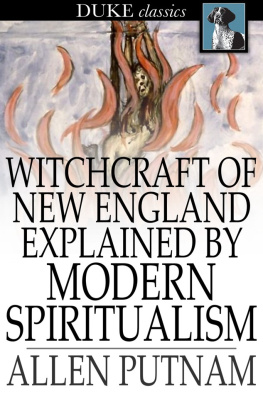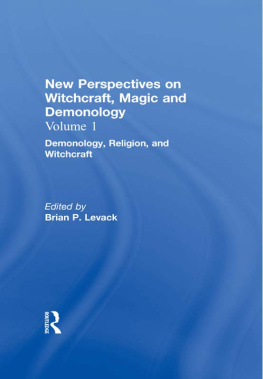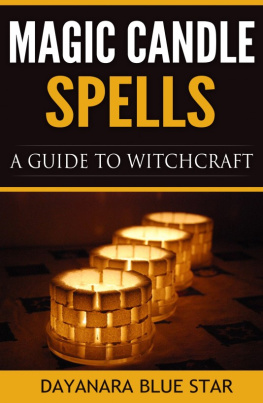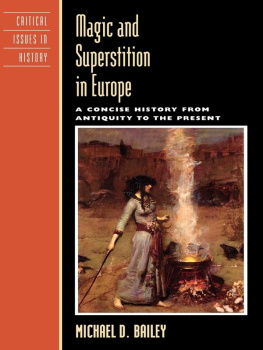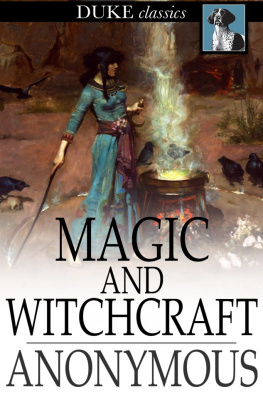Frederick Valletta - Witchcraft, Magic and Superstition in England, 1640–70
Here you can read online Frederick Valletta - Witchcraft, Magic and Superstition in England, 1640–70 full text of the book (entire story) in english for free. Download pdf and epub, get meaning, cover and reviews about this ebook. year: 2017, publisher: Routledge, genre: Religion. Description of the work, (preface) as well as reviews are available. Best literature library LitArk.com created for fans of good reading and offers a wide selection of genres:
Romance novel
Science fiction
Adventure
Detective
Science
History
Home and family
Prose
Art
Politics
Computer
Non-fiction
Religion
Business
Children
Humor
Choose a favorite category and find really read worthwhile books. Enjoy immersion in the world of imagination, feel the emotions of the characters or learn something new for yourself, make an fascinating discovery.
- Book:Witchcraft, Magic and Superstition in England, 1640–70
- Author:
- Publisher:Routledge
- Genre:
- Year:2017
- Rating:5 / 5
- Favourites:Add to favourites
- Your mark:
- 100
- 1
- 2
- 3
- 4
- 5
Witchcraft, Magic and Superstition in England, 1640–70: summary, description and annotation
We offer to read an annotation, description, summary or preface (depends on what the author of the book "Witchcraft, Magic and Superstition in England, 1640–70" wrote himself). If you haven't found the necessary information about the book — write in the comments, we will try to find it.
Witchcraft, Magic and Superstition in England, 1640–70 — read online for free the complete book (whole text) full work
Below is the text of the book, divided by pages. System saving the place of the last page read, allows you to conveniently read the book "Witchcraft, Magic and Superstition in England, 1640–70" online for free, without having to search again every time where you left off. Put a bookmark, and you can go to the page where you finished reading at any time.
Font size:
Interval:
Bookmark:

Devil | The personification of supreme evil. When used in the plural, devils means fiends, imps, demons etc. |
Devils mark | Stigmata diaboli. Often confused with the witchs mark (a protuberance on the body from which the familiar gained sustenance). The devils mark resembled a birthmark. It was generally thought to be insensitive and did not bleed. |
Familiar | Sometimes called imp. Exclusive to England and Scotland. A low-ranking demon given by the devil to the witch, usually taking the form of a small domestic animal. The term was first officially mentioned in the Witchcraft Act of 1604. |
Incubus | Believed to have been an angel who had fallen from Heaven because of a lust for women. A lecherous demon who sought to corrupt women into following the devil through the act of sexual intercourse. See also Succubus. |
Lycanthropy | Arose out of hallucinations and a sadistic craving for blood. Its features were: transformation into an animal; nocturnal excursions into the countryside; attacks on animals and humans to devour their flesh; retransformation into human form. |
Maleficium | Misfortunes, injuries and calamities suffered by persons or animals with no apparent explanation. Often attributed to the malice of witches. |
Metamorphosis | The belief that humans could change shape into animal form. |
Poltergeist | A German word, deriving from spirit (geist) that makes a noise or uproar (polter). |
Pricking | To detect the witchs mark. A long pin was stuck in the mark and if no pain was felt and there was no bleeding then this was used as proof that the suspect was a witch. |
Sabbath | A parody of Christian rites. An assembly of witches presided over by the devil or a demon. |
Scratching | The drawing of blood from a suspected witch in the belief that this would cure the person bewitched. |
Sorcery | Differentiated from witchcraft. A timeless belief in the ability that man could control nature to produce good or evil results, often aided through incantations, spells or spirits. The witch might engage in sorcery, but also contracts with the devil. |
Succubus |
Font size:
Interval:
Bookmark:
Similar books «Witchcraft, Magic and Superstition in England, 1640–70»
Look at similar books to Witchcraft, Magic and Superstition in England, 1640–70. We have selected literature similar in name and meaning in the hope of providing readers with more options to find new, interesting, not yet read works.
Discussion, reviews of the book Witchcraft, Magic and Superstition in England, 1640–70 and just readers' own opinions. Leave your comments, write what you think about the work, its meaning or the main characters. Specify what exactly you liked and what you didn't like, and why you think so.

